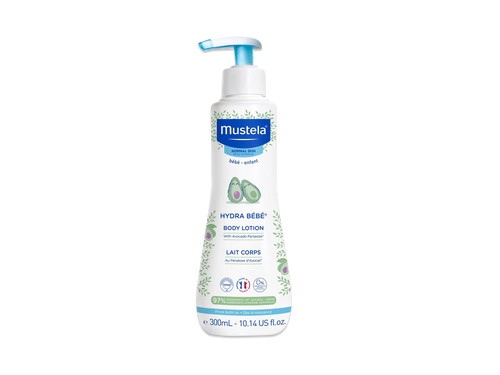Your baby is probably growing so quickly that you can hardly believe your eyes. With the extra baby weight, alertness, and cuddles increasing every day, you might be wondering: when do babies start rolling over?
Our experts have the answer. Read on to understand when your baby will begin rolling over, why they do it, and what other milestones should be following soon after!
When Do Babies Start Rolling Over?
Some newborn babies may roll over onto their sides while they sleep at night (which is safe as long as they roll back and forth on their own and are in a secure place!). But over the next several days, they will probably lose this ability.
From there, it takes at least four months for your baby to gain enough upper body strength and muscle to turn themselves onto their belly or back. Your little one will likely start by rolling from belly to back. Gravity and momentum are on their side at this point!
If you notice your baby trying to roll from their back to their belly, don’t help them! Rolling from back to belly successfully means your baby has lots of strength. You can assume if they can roll themselves onto their stomach, they are able to do the reverse.

Like most milestones, each baby is unique. So their “ah-ha!” moment may take more or less time than the average baby.
Typically, you can expect your little one to roll from their tummy to their back between 3 and 5 months old. Back-to-side rolls will happen a little later, between 4 and 5 ½ months. And, finally, back-to-tummy rolls will probably come last, between 5 ½ and 7 months.
As we mentioned, if your baby rolls from their back to their tummy before other milestones, you can assume they are strong enough to do it all!
How Do Babies Learn To Roll Over?
This is where all that tummy time comes in handy. Tummy time is essentially baby weight training. It forces your little one to begin building neck and upper body strength.
While your infant is on their stomach, you may notice them trying to lift their head off the ground. They will graduate to holding their head steady and looking around. This is great progress!
Lifting their head while on their tummy should be followed by little rocks back and forth. This is your baby’s way of testing the waters –– figuring out how to take the plunge.
Little baby push-ups against the ground are the final preliminary step. Once they can clear their chest from the ground, they should be very close to rolling all the way over.
Some babies take longer than others. If your little one hits their 6-month mark and still seems uninterested in turning over, let your doctor know and they can tell you how to proceed.
What Affects Your Baby’s Ability To Roll Over?

As we’ve highlighted above, babies develop at different rates, and they will naturally start rolling over at different months. There are, however, some factors that may affect when your baby reaches this significant milestone.
Prematurity
If your little one was born prematurely, your doctor might have already explained the importance of using their “corrected” age when looking at milestones. But what does this mean?
In a nutshell, it takes about 40 weeks for all the organs and systems in a baby’s body to reach the necessary point of maturity that a newborn needs. A child born before this time will continue to develop as if they are still in their mother’s womb.
A simple way of calculating their corrected age is by subtracting the number of weeks your child was born from their actual age in weeks.
For example, if your six-month-old baby was born two months premature, they are expected to meet the developmental milestones of four-month-old, full-term babies.
As the parent of a preemie, it’s important not to compare their development to their peers, as they are likely to hit most of their milestones a little later.
The good news is this won’t be the case forever! At around two years old, most premature babies tend to catch up developmentally.
Geographic Location
It’s no surprise that people in different cultures and geographic locations around the world behave differently. But can these differences also influence how a baby rolls over?
According to an old study, the answer is yes. The study, Rolling Over in Infants: Age, Ethnicity, and Cultural Differences, found many interesting differences in how babies in various parts of the world start rolling over.
For example, babies in the US often roll from their stomachs to their backs first, while their peers in China or Hong Kong start rolling from back to belly.
Practice
Rolling over is a developmental milestone that all babies eventually reach. However, you can also think of it as a skill that demands a lot of practice because babies who roll over earlier tend to have gotten more time training (i.e., tummy time).
While it’s important to ask yourself, “When do babies start rolling over?”, it’s equally important to understand that children develop differently, so comparing them is often not the best solution.
Remember that as long as their healthcare provider is happy with your little one’s development, hitting some milestones a bit later than the average baby is perfectly fine!
How To Help Your Baby Roll Over

There are a few different ways to encourage muscle growth in your baby and, consequently, rolling over!
Limit Time In Baby Equipment
Try to limit the amount of time your baby spends in swings, bouncers, or play mobiles. Your baby needs experience and practice in order to build strength. Baby equipment, though fun, prevents them from flexing those muscles!
Encourage Tummy Time
Tummy time is key. This is where your baby builds their motor skills. It assists in stretching and strengthening their arms, neck, back, and shoulder muscles, which are important components to helping them eventually start rolling over.
Tummy time should begin as soon as they are brought home as newborns, for at least 15 minutes a day. Their little body needs plenty of time to build the muscles they’ll need for the great 180.
That said, rolling over is not the only reason why tummy time is essential for your growing baby. This activity can:
- Prevent flat spots on the back of your little one’s head. Babies spend a lot of time sleeping, especially during their first few months. For safety, parents are always encouraged to place infants on their backs. Unfortunately, this can lead to flat spots on their heads. Tummy time is one of the preventative measures that can help with this problem.
- Give your child the foundation to perform other movements. As your child works on their tiny muscles during tummy time, they will use this strength to help them sit up, crawl, walk, and perform many other movements.
Sometimes babies don’t love tummy time. To help with this, you can try laying them over your lap or placing them on your chest, facing you.
Studies are ongoing about why some babies aren’t fans of tummy time, but not being able to see you while they’re down might be a reason for their restlessness. The chest position might just be the perfect way to get some tummy time in while ensuring your little one that you’re still around.
Practice Supported Rolling
Help your baby learn to roll over by simulating the feeling of them rolling through their side.
The best time to do this is during diaper changes — lower your baby onto their side while supporting their neck, then let them “roll” down onto their back with your support!
Be sure to give them a little extra love with all those frequent diaper changes, too. Our EWG Verified Diaper Cream with Olive Oil and Aloe is fragrance-free and perfect for even the most sensitive skin!
Additionally, our Diaper Rash Cream 1 2 3 is a 3-in-1 product that prevents diaper rash and relieves and recovers your baby's delicate skin at every diaper change.
Use A Toy
While your baby is on their tummy, use a favorite toy of theirs to entice them to reach out. As they try to grab the toy, pull it slightly above their head. Your baby will be motivated to roll in the direction where you moved the toy.

Get On Their Level
Your baby will be more engaged if you get down on your stomach or back with them from time to time. Two is a party, after all!
While you’re on their level, you can talk to them, sing, read books, or do any type of engaging activity.
Don’t always assume that you have to be super creative to get your little one’s attention. Sometimes, all you need to do is just smile! In fact, smiling can help them feel happy and safe and forget for a moment how much strength and effort they are using while on their tummy.
Smiling can also help you build a bond with your little one, so don’t forget to do this simple thing, even while participating in other activities.
Offer Plenty Of Praise
Your baby may be young, but they are still emotionally intelligent. Give lots of kisses and cheers so they know they are doing a good job!
Don’t worry about marking off all of these activities every day (minus tummy time, which should be done every day at multiple intervals). Your baby will develop in their own time. But every now and then, it’s nice to give them that extra nudge in the right direction!
Keeping Your Rolling Baby Safe

As soon as your little one has discovered the exciting new world they can experience by rolling over, they will be practicing a lot! But, unfortunately, this may mean exposure to different dangers as well.
Many parents wait until their child is crawling to start thinking about baby-proofing their home. However, there are a few areas you’ll need to focus on to ensure that your little one is safe while they continue practicing their new rolling skills.
Focus On Crib Safety
Babies are notorious for sleeping a lot, especially during the first few months of life. According to Stanford Children’s Health, babies get between 14 to 16 hours of sleep per day during their first year.
This means that your little one is spending a significant amount of time in their crib, so making it safe, especially when they start rolling over, is critical.
Crib safety for babies means removing any crib bumpers, toys, pillows, blankets, stuffed animals, or other items from the crib while they are sleeping because these can be a suffocation hazard.
The only item that should be in the crib while your baby snoozes is a fitted sheet, and this sheet should be perfectly snug around the mattress.
Practice Safe Diaper Changing
While doing a diaper change, it’s important to keep one hand on your baby for safety, but you might not feel the need to because you know your little one can’t roll over yet. But this can be a disaster waiting to happen!
Your baby could begin rolling over at any moment, so it’s absolutely necessary to keep either one of your hands on them or position your body right next to them to block them from falling while using any elevated surface, like a changing table.
Stop Swaddling When It’s Time
Swaddling is one of those great techniques that can help calm infants and improve their sleep (and yours!). It’s no surprise that so many parents swear by it. However, as soon as your little one starts rolling, it’s best to hang up the swaddle.
Note: If your baby is having trouble sleeping without a swaddle, you can choose to transition them to a sleep sack to help make the process gradual until they’re ready to sleep without it.
Keep Your Eyes On Them
While having your baby roll over is exciting because of the gross motor development that’s taking place, the challenge comes when they start rolling themselves into positions and areas that can harm them.
Rolling babies have the ability to end up under the couch, next to that plugged-in charger, or even by the staircase. So, if you haven’t already, this is the perfect time to babyproof your home thoroughly.
While doing so, look into giving your baby a soft and comfortable place to continue their rolling shenanigans. A thick carpet, blanket, or mat will work wonderfully!
And if your little one still gets a boo-boo even after all of your protective measures, turn to Mustela Cicastela Moisture Recovery Cream to relieve skin discomfort by delivering cooling hydration.

Is It OK For Babies To Roll Over While Sleeping?
Most parents are concerned about babies rolling over due to the chance of Sudden Unexpected Infant Death (SUID), which includes suffocation and Sudden Infant Death Syndrome (SIDS).
As long as your baby’s sleep area is clear and there is nothing they could potentially roll into, they should be OK. Rolling over is a natural part of a baby’s growth, so it’s a good sign that your little one is able to roll themselves over in their sleep!
Just keep in mind that, per the American Academy of Pediatrics (AAP), babies under one year old should never have loose bedding, toys, or soft materials in their sleep area.
You should also always ensure that in the first year of their life, all caretakers are placing your baby on their back whenever they go to sleep. This includes naps and longer sleep sessions. Infants who begin sleeping on their backs have the lowest risk for SIDS.
If your baby is new to rolling, keep an eye on them to make sure they do not wake up and upset themselves in the middle of the night. If they seem settled, then they should be safe to continue sleeping in their rolled-over position.
If you ever have any concerns about how rolling over might impact your baby’s sleep patterns or health, we recommend checking with your pediatrician. They know you and your little one best and can give you the most appropriate advice.

What Comes Next?
With those new, strong neck muscles and a sense of balance, it won’t be long before your little one graduates from rolling over. Soon (with a little push in the right direction!) they will be sitting up, eventually unassisted.
After sitting up, you will have a budding crawler on your hands. Your baby will begin exploring all the parts of your house (make sure to babyproof your home!). Babies typically start to explore crawling around 6 months of age.
Once they seem to crawl faster than you’ve seen any grown man run, they will toddle and teeter their way into walking between 9 and 18 months old (with, unfortunately, lots of head-knocking along the way).
If your little one seems to be falling a little behind the average, this does not necessarily mean you have to worry. Every baby is unique and will reach milestones like rolling over, sitting up, walking, and talking on their own time!
But if you’re concerned about your baby’s development, it’s always best to contact your doctor and tell them what you have observed. They can reassure you about your baby’s progress.
Sometimes knowing when to contact your baby’s doctor can be challenging, especially when you’re constantly reading that babies develop differently. If this is the case, how are you to know that something just isn’t right?
There are few signs to look for. Reach out to your baby’s doctor immediately if:
- Your baby seems unable to control his or her movements
- By the age of 6 months, your little one cannot roll from stomach to back
- Your baby starts rolling over but then loses this skill (and apply this point to any other developmental milestones for your little one)
Expert tip: With your little one getting rough and tough as they grow stronger, their skin might need a little extra TLC, too. Our Hydra Bebe Body Lotion is the perfect product to keep your baby’s skin silky smooth and deeply hydrated –– no dry skin for your little daredevil!
And our Certified Organic Hydrating Cream with Olive Oil and Aloe is fragrance-free, EWG Verified, and can be used by the whole family. That includes you too!
When Do Babies Start Rolling Over: What To Remember
Rolling over is the first major milestone in your baby’s motor development. It is an exciting (and sometimes scary) time for you and your child!
Keep these things in mind as your baby begins their adventure from back to tummy and back again:
- Most babies won’t begin rolling over until at least 4 months of age.
- Tummy time is the most important daily activity to help your baby build strength.
- If you notice your baby roll over in their crib at night, don’t panic! This means they are strong enough to roll themselves back and forth and can likely sense trouble while they are asleep.
- To reduce the risk of SIDS, continue to put your baby to sleep on their back for at least the first year of their life. If they roll out of that position on their own, it is OK.
We all know growing up can be hard work (almost as much as parenting), so cherish this first big achievement with your baby. Because, soon, they will be crawling and walking and getting into who-knows-what!














